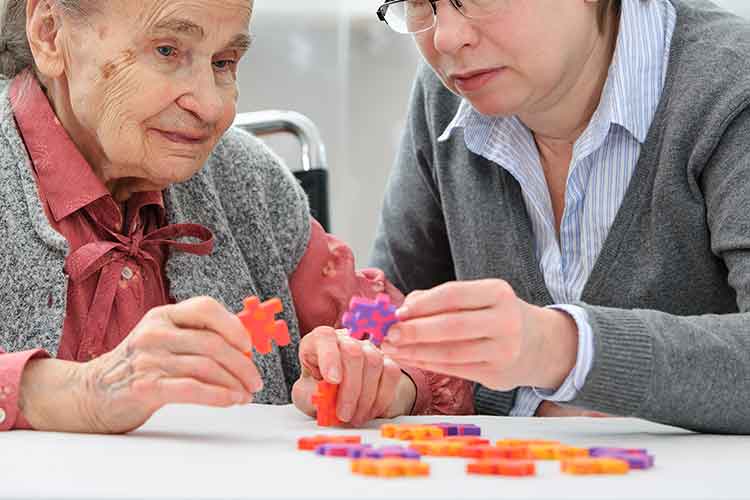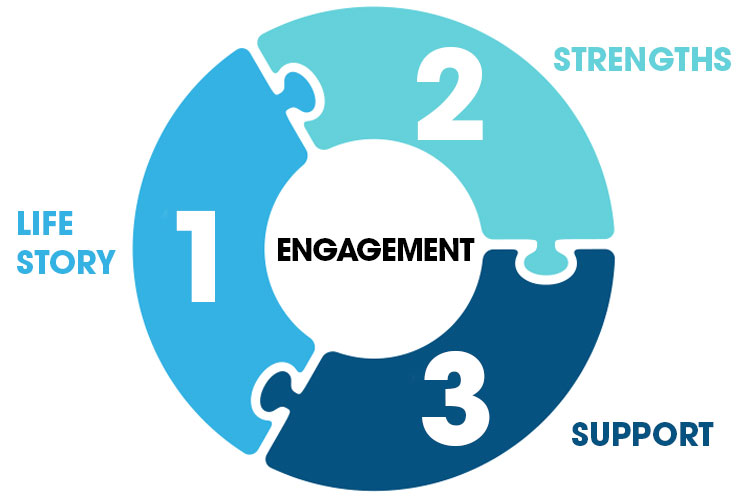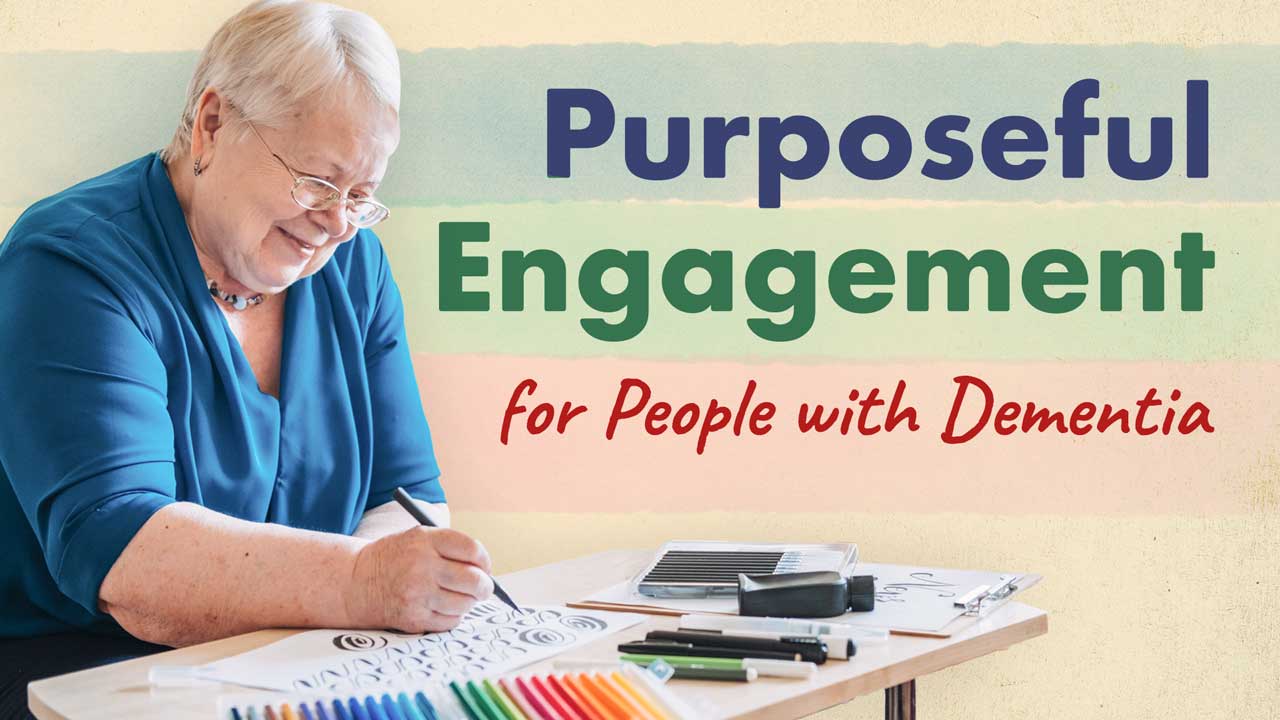A person’s strengths and abilities can vary greatly depending on their stage of dementia. What stays unchanged, however, is the need for engagement and involvement to maintain a good quality of life.
By designing activities that promote meaningful engagement, we can ensure these needs continue to be met, long into the progression of their illness.
This article will provide you with a foundational understanding of purposeful engagement and activity design, which is essential to ensuring that people with dementia receive effective person-centred care.
What is Purposeful Engagement?

People who have dementia may exhibit signs of apathy and withdrawal, such as falling asleep or seeming uninterested or unmotivated (Alzheimer’s Society 2025). This can make engaging them difficult.
Purposeful engagement is a person-centred approach to engaging a person with dementia so they can continue to participate in activities and contribute to what is going on around them. It utilises the person’s interests and strengths to tailor activities that the person is more likely to engage in (Alzheimer Society 2015).
Montessori
The concept of purposeful engagement is based on the Montessori education technique. First used for child development, the Montessori technique has been adapted and is now widely recognised as an effective non-pharmacological intervention and engagement technique for people living with dementia (Henderson 2021).
Montessori for dementia supports memory loss and encourages independence through the use of environmental cues and experimentation (within safe boundaries). It has been found to help the person with dementia make meaningful contributions to their community, increase their engagement in activities, and, in some instances, circumvent the effects of dementia (Kelly 2025).

Benefits of Purposeful Engagement for People with Dementia
Purposeful engagement:
- Provides the person with a sense of purpose and routine
- Acknowledges the person’s skills and life experiences and provides an appropriate outlet for these strengths
- Is an emotionally nurturing experience that increases self-esteem and helps the person feel a sense of accomplishment
- Provides an opportunity for social contact and connection
- Helps the person maintain their skills and independence, and in some cases, improve their capacity to perform certain daily activities
- Provides the person with an opportunity for decision-making and choice
- Helps care staff to get to know their clients on a personal level.
(Alzheimer Society 2015; Dementia Australia 2025)
Engagement
Dementia Australia (2015) defines these three components as essential for developing meaningful engagement:
- The person’s life story and experiences;
- The person’s strengths
- Individualised supports.

1. Life Story
Getting to know the person behind the illness is an essential part of person-centred care. In order to develop activities that someone will want to engage in, you need to get to know the person.
This can be achieved by interviewing the person about their life, which is also a great engagement opportunity in itself. Ask questions such as:
- What did they previously do for work?
- What hobbies do/did they have?
- What makes them happy?
(Dementia Australia 2015)
It may also be beneficial to involve the person’s family or loved ones in this process for additional insight or for people with whom verbal communication is difficult.
2. Strengths
Assessing a person’s strengths is essential to tailoring activities to suit them. This can be done through simple observation during an activity. Consider the following strengths and how they can be utilised:
- Motor skills: Carrying, cutting and pouring could be utilised by getting the person to help serve food and drinks.
- Sensory strengths: Hearing, smelling and sight could be used for arranging flowers.
- Cognitive skills: Counting, reading aloud and sorting could be utilised in reading groups, games or puzzles.
- Social strengths: Conversation, humour and leadership skills can be used in facilitating discussions, handing out name tags, etc.
(Dementia Australia 2015)
3. Support
Once a person’s strengths have been assessed, consider what gaps exist and what can be done to support them. For example:
- Environmental supports such as removing clutter, keeping spaces well-lit, removing distractions and unnecessary noises, using contrasting colours when designing spaces, and having clear signage.
- Providing a warm, relaxed and positive environment for emotional support.
- Providing health supports for any comorbid conditions that the person may have.
- Staff allocations.
(Dementia Australia 2015)
Note that supports will change with the person’s needs and should constantly be reassessed and updated.

Tips for Presenting Activities
- Establish safe physical boundaries for the activity
- Verbally invite the person to join in the activity, if they would like to
- Break the task into small steps, or demonstrate how to do the activity first
- Give the person something to hold or touch
- Thank the person for their help and ask them if they enjoyed it, and whether they would like to do it again next time
- Offer different activities at the same time, so the person can independently select which they would prefer
- Don’t allow activities to reinforce inadequacy, overstimulate or increase the person’s stress
- Consider timing (e.g. not too early or too late in the afternoon).
(Dementia Australia 2015; Alzheimer Society 2015; King 2003)
Examples of Activities for People with Dementia
- Painting or drawing
- Jigsaw puzzles
- Gardening or flower arranging
- Engaging with children or dogs/animals
- Reading groups
- Social events
- Photo albums
- Discussion and group reminiscing
- Setting a table
- Sorting items by colour
- Folding clothes or pairing socks
- Washing/drying dishes
- Preparing food or pouring drinks
- Distributing and serving food and drinks
- Dancing or listening to music
- Sensory experiences
- Creating a memory/rummage box
- Untying knots
- Boxes of different textured materials
- Playing cards
- Gentle massages
- Short walks.
(Dementia Australia 2025; Chow 2025; King 2003; Golden Carers 2016)
Test Your Knowledge
Question 1 of 3
What is the primary goal of purposeful engagement in dementia care?
Topics
References
- Alzheimer Society 2015, Meaningful Engagement of People with Dementia: A Resource Guide, Alzheimer Society, viewed 16 September 2025, https://alzheimer.ca/en/get-involved/become-dementia-friendly/meaningful-engagement-people-living-dementia
- Alzheimer’s Society 2025, Apathy and Dementia, Alzheimer’s Society, viewed 16 September 2025, https://www.alzheimers.org.uk/about-dementia/stages-and-symptoms/apathy-dementia
- Chow, C 2025, ‘10 No Fail Activities for People with Dementia’, DailyCaring, 1 January, viewed 16 September 2025, https://dailycaring.com/activities-for-people-with-dementia-10-fun-no-fail-ideas/
- Dementia Australia 2015, Purposeful Activities for Dementia: Alzheimer’s Australia VIC, online video, 1 June, viewed 16 September 2025, https://www.youtube.com/watch?v=9Y6LCpL8HUU
- Dementia Australia 2025, Activities for People with Dementia, Dementia Australia, viewed 16 September 2025, https://www.dementia.org.au/living-dementia/staying-connected/activities-people-dementia
- Golden Carers 2016, 20 Practical Activities for People Living with Alzheimer’s Disease, Golden Carers, viewed 16 September 2025, https://www.goldencarers.com/20-practical-activities-for-people-living-with-alzheimers-disease/3778
- Henderson, W 2021, The Montessori Approach to Activities and Dementia [webinar], Dementia Australia, viewed 16 September 2025, https://youtu.be/wDi-9m1v9fQ?si=uz_TT6-NNPobirfW
- Kelly, A 2025, Montessori, Changing the Lives of People Living with Dementia, Montessori for Dementia, viewed 16 September 2025, https://montessorifordementia.com.au/
- King, D 2003, Activities: A Guide for Carers of People with Dementia, Alzheimer Scotland, viewed 16 September 2025, https://blessedjamesbell.co.uk/wp-content/uploads/2020/04/A-guide-for-carers-of-people-with-dementia.pdf
 New
New 
